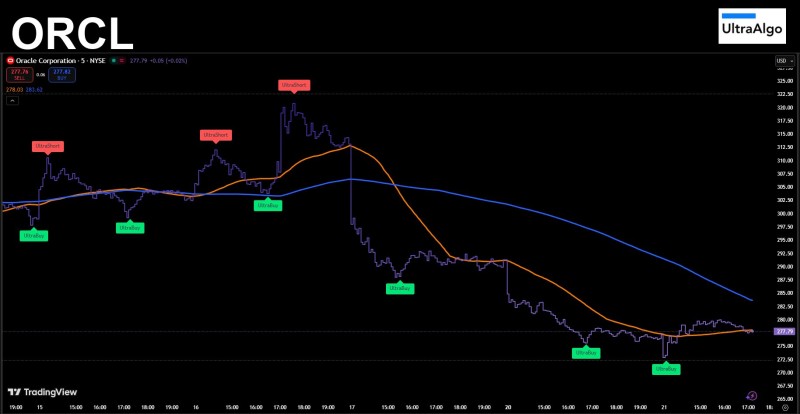Oracle (NYSE: ORCL) has hit an important technical level that could shape its next move. After sliding for several sessions under selling pressure, the stock is now testing support around $277. Recent UltraBuy signals from UltraAlgo suggest the downward momentum might be easing, raising the possibility of a short-term rebound.
Technical Picture
The 5-minute chart shows Oracle's price stabilizing near $277.7, forming what could be a temporary base. According to UltraAlgo™, this setup might mark the start of a relief rally if buyers defend this level.

The chart shows a clear downtrend since mid-October, with the stock making lower highs and lower lows. The short-term moving average (orange line) sits below the longer-term trend line (blue), confirming the bearish bias remains intact. But here's what's changed: multiple UltraBuy signals have popped up around the same price zone, suggesting automated systems are picking up on potential oversold conditions. This clustering around $277 often comes before at least a modest bounce. Support sits between $277.0 and $277.5, having been tested several times. Resistance looms in the $282–$285 range, where previous sell signals appeared. The trend is still bearish short-term, though early signs of stabilization are emerging. If the price breaks above the short-term average with solid volume, it could trigger a technical rebound toward the $283–$285 area.
Market Context
Oracle's weakness mirrors what's happening across the broader tech sector. Rising Treasury yields and worries about slower enterprise software spending have weighed on cloud and data infrastructure stocks. Investors have been rotating out of big tech into defensive sectors as economic uncertainty builds. Competition in the AI space from Microsoft and Amazon's cloud offerings adds another layer of pressure. Some traders are also cutting positions ahead of Oracle's next earnings report. Still, Oracle's cloud infrastructure growth and AI integration into enterprise solutions continue to support a positive long-term view, even as near-term headwinds persist.
 Saad Ullah
Saad Ullah

 Saad Ullah
Saad Ullah

